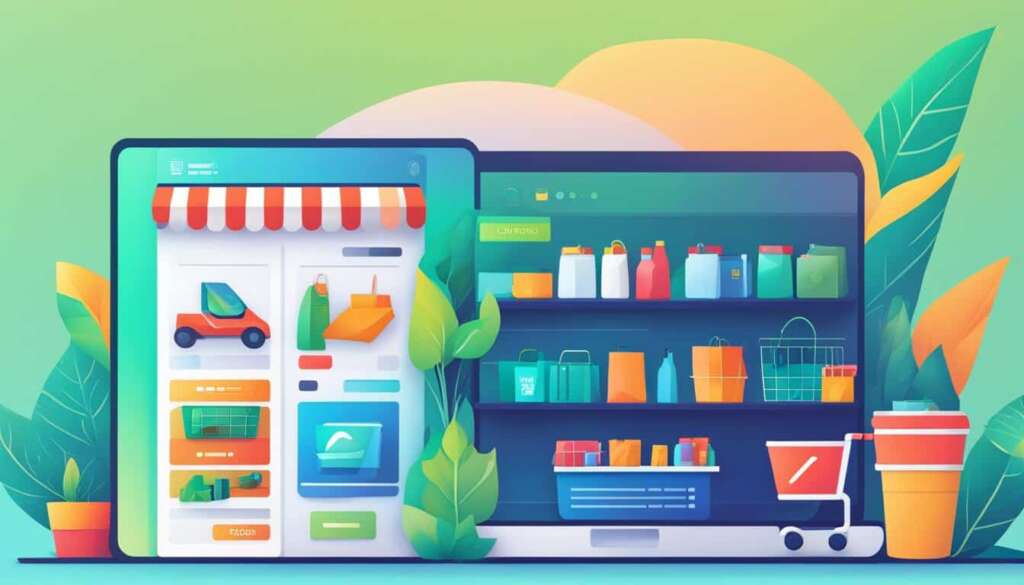Table of Contents
Welcome to our article on e-commerce websites! In today’s digital age, online shopping has become increasingly popular, revolutionizing the way we conduct business transactions. E-commerce, or electronic commerce, refers to the buying and selling of goods and services over the internet. It encompasses a range of transactions, including business-to-business (B2B), business-to-consumer (B2C), consumer-to-consumer (C2C), and consumer-to-business (C2B).
E-commerce has experienced significant growth in recent years, with platforms like Amazon and eBay playing a major role in the rise of online retail. In fact, e-commerce accounted for 5% of total retail sales in 2011 and reached an impressive 16.5% during the COVID-19 pandemic in 2020.
Online shopping has become synonymous with convenience and accessibility, enabling customers to browse and purchase products from the comfort of their own homes. E-commerce websites serve as virtual storefronts, allowing businesses to showcase their offerings, process orders, accept payments, and provide customer service. Whether you’re a consumer looking for the latest trends or a business looking to expand your reach, e-commerce websites are the gateway to a world of possibilities.
Join us as we delve deeper into the fascinating world of e-commerce, exploring how it works, the different types of e-commerce, its advantages and disadvantages, and the steps involved in starting an e-commerce business. Stay tuned to unlock the secrets of successful online shopping and uncover the endless opportunities that e-commerce has to offer.
How Does E-commerce Work?
E-commerce operates through the internet, with customers using their own devices to access online stores. When an order is placed, the customer’s web browser communicates with the server hosting the e-commerce website. Data related to the order is then relayed to the order manager, which connects to various systems, including those managing inventory levels, payment information, and banking. The order manager validates the order and notifies the web server, which in turn notifies the customer that their order has been processed. The order data is then sent to the warehouse or fulfillment department for shipping or service access.
How Does E-commerce Work in Detail?
When a customer decides to make a purchase from an e-commerce website, they use their web browser to access the online store. The customer can browse through the various products and select the items they wish to buy. Once the customer has made their selection, they proceed to the checkout process.
During the checkout process, the customer’s web browser sends the order details, such as the selected items and shipping information, to the server hosting the e-commerce website. This server acts as the central hub for processing all incoming orders and managing the various components of the e-commerce system.
The order manager, which is a critical component of the e-commerce system, receives the order details from the server. The order manager is responsible for coordinating the different aspects of the order fulfillment process. It connects with various systems, including those managing inventory levels, payment information, and banking.
Firstly, the order manager checks the availability of the selected items in the inventory management system. If the items are in stock, the order manager proceeds to validate the order. It verifies the customer’s payment information, ensuring that the payment was successful and that the customer’s account has been debited.
Once the order has been validated, the order manager sends a notification to the web server, indicating that the order has been processed successfully. The web server then generates an order confirmation page or sends an email to the customer, providing them with the necessary information about their purchase, including the order number and estimated delivery date.
Simultaneously, the order data is sent to the warehouse or fulfillment department. The warehouse staff or fulfillment team then prepares the order for shipping or service access. They pick the items from the inventory, pack them securely, and generate a shipping label for the carrier.
The packaged order is then handed over to the shipping carrier, who is responsible for delivering the order to the customer’s specified address. The shipping carrier provides tracking information, allowing the customer to monitor the progress of their shipment.
Once the customer receives the order, they can confirm its accuracy and quality. If they encounter any issues or have any questions, they can contact customer support for assistance.
Benefits of E-commerce for Businesses and Customers
E-commerce offers numerous benefits to both businesses and customers. For businesses, it provides a platform to reach a global audience, expand their customer base, and operate 24/7. Online stores eliminate the need for physical locations, reducing overhead costs and allowing businesses to offer competitive prices. Businesses can also leverage advanced technologies to personalize the shopping experience, provide targeted recommendations, and streamline the order management process.
For customers, e-commerce offers convenience and accessibility. They can shop from anywhere and at any time, using their preferred device. E-commerce provides a wide range of products and services to choose from, with the ability to compare prices and read reviews from other customers. Additionally, online transactions are secure, thanks to robust payment processing systems and encryption technologies.
Types of E-commerce
E-commerce encompasses various types of transactions, catering to the needs of different parties involved. Understanding these types is crucial for businesses and consumers alike. Let’s explore the different classifications within the e-commerce landscape:
B2B (Business-to-Business)
In B2B e-commerce, transactions occur between businesses. It involves the exchange of goods, services, or information between organizations. B2B e-commerce platforms provide a streamlined process for businesses to connect, collaborate, and trade with their partners, suppliers, and distributors.
B2C (Business-to-Consumer)
B2C e-commerce refers to the sales of products or services from businesses directly to individual consumers. It is the most common type of e-commerce, with online retailers such as Amazon and eBay serving as prime examples. B2C transactions enable consumers to conveniently purchase goods and services online.
C2C (Consumer-to-Consumer)
C2C e-commerce enables consumers to trade products or services with each other. Online marketplaces like eBay and Etsy facilitate C2C transactions by providing a platform for individuals to buy and sell products directly to one another. This type of e-commerce promotes peer-to-peer interaction and allows consumers to monetize their personal belongings or skills.
C2B (Consumer-to-Business)
C2B e-commerce refers to transactions where consumers offer their products or services to businesses. Individuals or freelancers can showcase their expertise or offerings to businesses through various online platforms. This type of e-commerce allows businesses to leverage the skills and resources of individual consumers to meet their needs.
B2A (Business-to-Administration)
B2A e-commerce involves transactions between businesses and public administration or government bodies. It includes activities such as online tax filing, procurement by government agencies, and other business interactions with governmental entities. B2A e-commerce streamlines administrative processes and enhances efficiency in business operations.
C2A (Consumer-to-Administration)
C2A e-commerce encompasses transactions between consumers and public administration or government bodies. Examples include paying taxes online, applying for government services, or accessing public resources through digital platforms. C2A e-commerce simplifies interactions between citizens and government agencies, providing convenience and accessibility.
M-Commerce (Mobile Commerce)
M-commerce, also known as mobile commerce, refers to online sales transactions conducted using mobile devices, such as smartphones and tablets. With the proliferation of mobile technology, consumers can shop and make purchases on-the-go, anytime, and anywhere, making m-commerce an increasingly significant segment of e-commerce.
Understanding the different types of e-commerce enables businesses and consumers to navigate the digital marketplace effectively. Each type presents unique opportunities and challenges, shaping the way we engage in online transactions and revolutionizing the world of commerce.
Advantages of E-commerce
E-commerce offers a multitude of advantages that have revolutionized the way we shop and conduct business transactions. These advantages include:
- Availability: With e-commerce, customers have round-the-clock access to online stores, allowing them to shop at their convenience. Whether it’s early in the morning or late at night, the virtual doors of e-commerce are always open, catering to the needs of busy individuals.
- Accessibility: E-commerce provides quick and easy access to a vast selection of goods and services. Customers can explore and compare products with just a few clicks, without the need to physically visit multiple stores. This accessibility enhances the overall shopping experience, saving time and effort.
- Speed of Access: The speed at which customers can access products and services through e-commerce platforms is unparalleled. With fast-loading websites and optimized user interfaces, customers can find what they need in seconds, avoiding the hassle of browsing through crowded physical stores.
- Selection of Goods and Services: E-commerce offers an extensive selection of goods and services, surpassing the limitations of physical stores. Customers can choose from a wide range of products, brands, and variations, finding exactly what they need or discovering new items that they may not have come across otherwise. This vast selection caters to diverse preferences and ensures customer satisfaction.
- International Reach: One of the key advantages of e-commerce is its ability to facilitate global trade. Customers can access products and services from around the world, breaking down geographical barriers. This international reach opens up new opportunities for businesses to expand their customer base and for customers to discover unique and exotic products.
- Lower Cost: E-commerce enables businesses to operate at lower costs compared to brick-and-mortar stores. Without the need for physical storefronts and extensive overhead expenses, e-commerce businesses can offer competitive prices to their customers. This cost-effectiveness benefits both businesses and consumers, leading to great savings.
- Personalization: E-commerce platforms utilize customer data to personalize the shopping experience. Through algorithms and AI-powered recommendation systems, customers receive tailored product suggestions based on their preferences and browsing history. This level of personalization enhances customer satisfaction and increases the likelihood of repeat purchases.
“E-commerce offers round-the-clock availability, quick access to products, a vast selection, easy accessibility, international reach, lower operating costs, and personalized experiences – all contributing to a seamless and convenient online shopping experience.” – E-commerce expert
These advantages highlight the transformative power of e-commerce, providing individuals and businesses with unprecedented opportunities in the digital marketplace.

| Advantages | Description |
|---|---|
| Availability | Round-the-clock access to online stores |
| Accessibility | Quick and easy access to a wide selection of goods and services |
| Speed of Access | Fast-loading websites for efficient browsing |
| Selection of Goods and Services | Extensive range of products and variations |
| International Reach | Access to global products and services |
| Lower Cost | Lower operating costs compared to physical stores |
| Personalization | Tailored product recommendations based on customer data |
Disadvantages of E-commerce
Despite the numerous advantages of e-commerce, there are certain drawbacks that customers may encounter when shopping online. These disadvantages include:
- Limited Customer Service: Unlike physical stores, e-commerce platforms may have limited customer support hours and online service options. This can make it challenging for customers to receive immediate assistance or resolve any issues they may have.
- Inability to See or Touch Products: One of the main drawbacks of online shopping is the inability for customers to physically see or touch the products before making a purchase. This can make it difficult to assess the quality, texture, or fit of an item, as customers are reliant solely on product images and descriptions.
- Shipping Wait Time: Another disadvantage of e-commerce is the wait time for product shipping. Depending on the location and shipping method, customers may have to wait several days or even weeks to receive their orders. This can be frustrating, especially for those who desire immediate gratification.
- Security Issues: Security concerns are a prominent disadvantage of e-commerce. Customers may hesitate to share their personal and financial information online due to fears of identity theft or data breaches. While many e-commerce platforms have implemented robust security measures, the risk of security breaches still exists.
“Despite the advantages of e-commerce, customers may face challenges such as limited customer service, the inability to physically examine products, shipping wait times, and potential security risks.”
It’s important for customers to weigh these disadvantages against the convenience and benefits offered by e-commerce. While these drawbacks can pose challenges, they can often be mitigated through careful research, reading customer reviews, and choosing reputable and secure online stores.
Comparing the Disadvantages of E-commerce
| Disadvantage | Description |
|---|---|
| Limited Customer Service | Customers may face limited support hours and online service options, making it difficult to receive immediate assistance. |
| Inability to See or Touch Products | Customers cannot physically examine products before purchase, relying solely on product images and descriptions. |
| Shipping Wait Time | Customers may experience delays in receiving their orders, depending on shipping methods and location. |
| Security Issues | Concerns about data security and personal information protection may deter customers from making online purchases. |
What is an E-commerce Website?
An e-commerce website is a digital platform where people can buy and sell physical goods, services, and digital products. It serves as the virtual storefront where businesses can showcase their products, process orders, accept payments, manage shipping and logistics, and provide customer service. E-commerce websites can facilitate various types of transactions, including B2C, B2B, C2C, C2B, and C2A. These websites enable businesses to reach a wider audience and conduct transactions entirely online.
Benefits of E-commerce Websites
| Benefits | Description |
|---|---|
| Accessibility | E-commerce websites allow customers to access products and services anytime and from anywhere, eliminating the constraints of physical store hours and locations. |
| Global Reach | With an e-commerce website, businesses can expand their customer base and reach customers globally, overcoming geographical limitations. |
| Convenience | Customers can shop from the comfort of their homes, avoiding the need to visit physical stores, saving time, and reducing effort. |
| Wide Selection | E-commerce websites offer a vast range of products and services, providing customers with numerous options to choose from. |
In today’s digital age, having an e-commerce website is essential for businesses looking to thrive in the online marketplace. It offers convenience, accessibility, and a diverse range of products and services for customers, while enabling businesses to reach a wide audience and conduct transactions efficiently. By embracing e-commerce, businesses can unlock new opportunities and stay competitive in a rapidly evolving digital landscape.
Starting an E-commerce Business
Are you looking to venture into the world of e-commerce? Starting an e-commerce business requires careful planning and strategic decision-making. Here are the crucial steps to get you started on the path to success:
1. Research Business Ideas
Begin by researching potential business ideas and identifying a profitable niche. Consider your interests, expertise, and the market demand for products or services. Conduct thorough market research to validate your ideas and ensure their viability.
2. Determine Target Market
Once you have a business idea, define your target market. Understand your potential customers’ demographics, preferences, and purchasing behaviors. This information will help you tailor your products, marketing strategies, and customer experiences accordingly.
3. Choose Online Channels
Select the online channels through which you will sell your products or services. This could include creating your own e-commerce website, leveraging popular marketplaces like Amazon or eBay, or both. Consider the advantages and disadvantages of each channel and choose the ones that align with your business goals.
4. Create Website
To establish your brand online, create an attractive and user-friendly website or online storefront. Ensure that your website reflects your brand identity, showcases your products effectively, and provides secure and convenient shopping experiences for your customers.
5. Develop a Fulfillment Strategy
Develop a comprehensive fulfillment strategy to manage product inventory, order processing, and shipping. This strategy should include considerations for warehousing, packaging, delivery options, and return policies. Streamlining your fulfillment process will contribute to customer satisfaction and loyalty.
6. Attract Customers
Implement marketing strategies to attract customers to your e-commerce business. Utilize a combination of search engine optimization (SEO), social media marketing, email campaigns, content marketing, and paid advertising to increase your online visibility and reach your target audience.
By following these steps, you’ll be well-prepared to launch your e-commerce business and navigate the competitive online marketplace. Remember, maintaining a customer-centric approach, continuous innovation, and adapting to changing market trends are critical for long-term success.
Good luck on your e-commerce journey!

| Step | Actions |
|---|---|
| 1 | Research Business Ideas |
| 2 | Determine Target Market |
| 3 | Choose Online Channels |
| 4 | Create Website |
| 5 | Develop a Fulfillment Strategy |
| 6 | Attract Customers |
Conclusion
E-commerce has revolutionised the way we shop and conduct business transactions. With its convenience, accessibility, and wide range of options, it has become an integral part of both consumers’ and businesses’ lives. Online stores, websites, and marketplaces have transformed the retail landscape, allowing people to buy and sell products and services from anywhere in the world.
As technology advances, e-commerce continues to evolve and shape the future of retail and business interactions. The ability to shop online has provided unprecedented convenience for consumers, who can now browse and purchase products with just a few clicks. Businesses, too, have benefited from the expansion of e-commerce, as it allows them to reach a global customer base and streamline their operations.
Furthermore, e-commerce has enabled a wide range of business transactions, including B2B, B2C, C2C, and C2B. It has fostered entrepreneurship and provided opportunities for individuals and businesses to connect, collaborate, and thrive in the digital marketplace. As e-commerce continues to gain momentum, it is essential for businesses to adapt and leverage this online shopping revolution to stay competitive in the ever-changing business landscape.
FAQ
What is e-commerce?
E-commerce, or electronic commerce, refers to the buying and selling of goods and services over the internet.
How does e-commerce work?
When an order is placed on an e-commerce website, the customer’s web browser communicates with the server hosting the website. The order data is then relayed to the order manager, which connects to various systems such as inventory management and payment processing. After validation, the order is processed, and the customer is notified. The order data is sent to the warehouse for shipping or service access.
What are the types of e-commerce?
E-commerce can be classified into several types, including business-to-business (B2B), business-to-consumer (B2C), consumer-to-consumer (C2C), consumer-to-business (C2B), business-to-administration (B2A), consumer-to-administration (C2A), and mobile commerce (m-commerce).
What are the advantages of e-commerce?
E-commerce offers round-the-clock availability, quick access to products and services, a wide selection of goods, easy accessibility, international reach, lower operating costs, and the ability to personalize and provide product recommendations.
What are the disadvantages of e-commerce?
Some disadvantages of e-commerce include limited customer service, the inability to see or touch products before purchase, the wait time for product shipping, and potential security issues.
What is an e-commerce website?
An e-commerce website is a digital platform where people can buy and sell physical goods, services, and digital products. It serves as the virtual storefront for businesses to showcase products, process orders, accept payments, manage shipping and logistics, and provide customer service.
How do I start an e-commerce business?
To start an e-commerce business, you need to research business ideas, determine your target market, choose online channels to sell through, create a website or online storefront, develop a fulfillment strategy, and attract customers through marketing strategies.
What is the future of e-commerce?
As technology continues to advance, e-commerce is expected to further evolve and shape the future of retail and business interactions.







